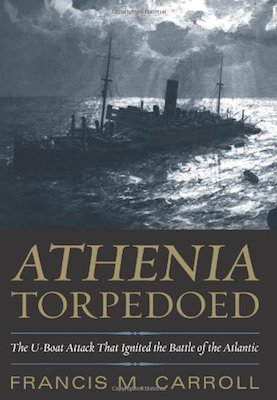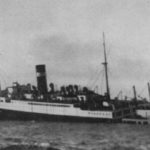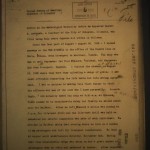I am sure every major historic event since the advent of printing and mass communications has been accompanied by a record of conflicting eyewitness accounts. People see and hear things differently, their perceptions often being colored by the rush of events, past experiences, or prejudices. So it’s not surprising that the sinking of the British passenger ship Athenia with more than 1,400 people on board — the events depicted in my novel Without Warning — resulted in conflicting descriptions of what happened.
One big difference between writing an objective history or a narrative account about such an event is what to do about these conflicts. A history, such as Francis Carroll’s excellent Athenia Torpedoed (Naval Institute Press, 2012), can note that while several passengers reported the U-boat surfaced and fired its deck gun at the torpedoed liner, sailors aboard U-30 said the deck gun was never used. For a writer seeking to envelop readers in a compelling narrative, such a notation would take them completely out of the storytelling experience. The challenge is to either ignore one of the conflicting accounts or find a way to resolve them, whichever serves the best interests of the story.
I saw a way to bring the two versions closer together after reading an account attributed to Georg Hӧgel, a radio operator aboard U-30. Hӧgel said that moments after firing the first torpedo at Athenia, the submarine fired a second torpedo, but it became stuck in the sub’s torpedo tube. He described a near panic in the forward torpedo room because the men knew the torpedo was “running,” its internal systems thinking it was on its way to a target. The torpedo was set for a magnetic detonation, meaning that once it armed itself it would detect the U-boat’s hull and explode. The arming device was a small propeller mounted on the torpedo’s nose that turned a set number of revolutions as it passed through the water. The torpedo tube doors were open and the tube had been flooded prior to firing, so if the propeller on the nose of the torpedo was turning while the U-boat moved through the water, the torpedo would soon be armed. At some point during the crew’s frantic efforts, the torpedo dislodged and exploded far enough from the submarine that it caused no damage.
For the sake of storytelling, it seemed reasonable that the U-boat commander, Oberleutnant Fritz-Julius Lemp, would have recognized the danger and ordered U-30 to surface immediately so that if the torpedo exploded, some of his men might survive. Once the torpedo was away, Lemp could have ordered U-30 to dive immediately, especially if he thought the ship he had just attacked was capable of firing on him. On the surface, the U-boat’s diesel engines would have started, with their attendant dense black cloud of exhaust. The diesels would have been needed to drive U-30 smoothly back under the waves.
These actions — the U-boat surfacing, a cloud of diesel exhaust and a torpedo exploding near the water’s surface — would have happened within seconds of each other and easily could have been perceived by those aboard Athenia as the firing of a deck gun at their ship. Because U-30 only would have surfaced for a minute or so before diving and her crew would have been focused on the frantic efforts to dislodge the torpedo, most crew members would have been unaware their boat had surfaced.
We can never know if events actually unfolded in this way, but it’s not unreasonable to say they did. In any case, the supposition makes for a much more dramatic narrative.
Up next, how many torpedoes did U-30 fire at Athenia?
Photo: Athenia Torpedoed book cover via Amazon.com





